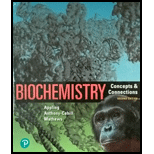
Concept explainers
(a) Interpretation:
Role of glu, tyr and asp should be identified.
Concept introduction:
Glutamine can also be denoted by E 117 and act as General acid catalyst in 1st step and helps in the catalysis of acid whereas it act as General base catalyst in another step.
Glutamine is consist of carboxyl group which attacks the hydroxyl of sialic acid and thus it act as a base catalyst and then it turns into carboxyl group whereas aspartic acid contains amino group which looses electrons to sialic acid and behaves as base.
Nuraminidase is an enzyme helps in hydrolysis of sialic acid which is present on cell surface as binded protein.
(b) Interpretation:
Effect of mutation of glu to ala on Km should be identified.
Concept introduction:
Glutamine can also be denoted by E 117 and act as General acid catalyst in 1st step and helps in the catalysis of acid whereas it act as General base catalyst in another step.
Glutamine is consist of carboxyl group which attacks the hydroxyl of sialic acid and thus it act as a base catalyst and then it turns into carboxyl group whereas aspartic acid contains amino group which looses electrons to sialic acid and behaves as base.
Nuraminidase is an enzyme helps in hydrolysis of sialic acid which is present on cell surface as binded protein.
(c) Interpretation:
How R374 stabilises the transition state should be identified.
Concept introduction:
Glutamine can also be denoted by E 117 and act as General acid catalyst in 1st step and helps in the catalysis of acid whereas it act as General base catalyst in another step.
Glutamine is consist of carboxyl group which attacks the hydroxyl of sialic acid and thus it act as a base catalyst and then it turns into carboxyl group whereas aspartic acid contains amino group which looses electrons to sialic acid and behaves as base.
Nuraminidase is an enzyme helps in hydrolysis of sialic acid which is present on cell surface as binded protein.
Want to see the full answer?
Check out a sample textbook solution
Chapter 8 Solutions
Biochemistry: Concepts and Connections (2nd Edition)
 BiochemistryBiochemistryISBN:9781319114671Author:Lubert Stryer, Jeremy M. Berg, John L. Tymoczko, Gregory J. Gatto Jr.Publisher:W. H. Freeman
BiochemistryBiochemistryISBN:9781319114671Author:Lubert Stryer, Jeremy M. Berg, John L. Tymoczko, Gregory J. Gatto Jr.Publisher:W. H. Freeman Lehninger Principles of BiochemistryBiochemistryISBN:9781464126116Author:David L. Nelson, Michael M. CoxPublisher:W. H. Freeman
Lehninger Principles of BiochemistryBiochemistryISBN:9781464126116Author:David L. Nelson, Michael M. CoxPublisher:W. H. Freeman Fundamentals of Biochemistry: Life at the Molecul...BiochemistryISBN:9781118918401Author:Donald Voet, Judith G. Voet, Charlotte W. PrattPublisher:WILEY
Fundamentals of Biochemistry: Life at the Molecul...BiochemistryISBN:9781118918401Author:Donald Voet, Judith G. Voet, Charlotte W. PrattPublisher:WILEY BiochemistryBiochemistryISBN:9781305961135Author:Mary K. Campbell, Shawn O. Farrell, Owen M. McDougalPublisher:Cengage Learning
BiochemistryBiochemistryISBN:9781305961135Author:Mary K. Campbell, Shawn O. Farrell, Owen M. McDougalPublisher:Cengage Learning BiochemistryBiochemistryISBN:9781305577206Author:Reginald H. Garrett, Charles M. GrishamPublisher:Cengage Learning
BiochemistryBiochemistryISBN:9781305577206Author:Reginald H. Garrett, Charles M. GrishamPublisher:Cengage Learning Fundamentals of General, Organic, and Biological ...BiochemistryISBN:9780134015187Author:John E. McMurry, David S. Ballantine, Carl A. Hoeger, Virginia E. PetersonPublisher:PEARSON
Fundamentals of General, Organic, and Biological ...BiochemistryISBN:9780134015187Author:John E. McMurry, David S. Ballantine, Carl A. Hoeger, Virginia E. PetersonPublisher:PEARSON





